3.1 Beginning to Create Images
3.2 Creating Still Images
3.3 Understanding Colors
3.4 File Formats

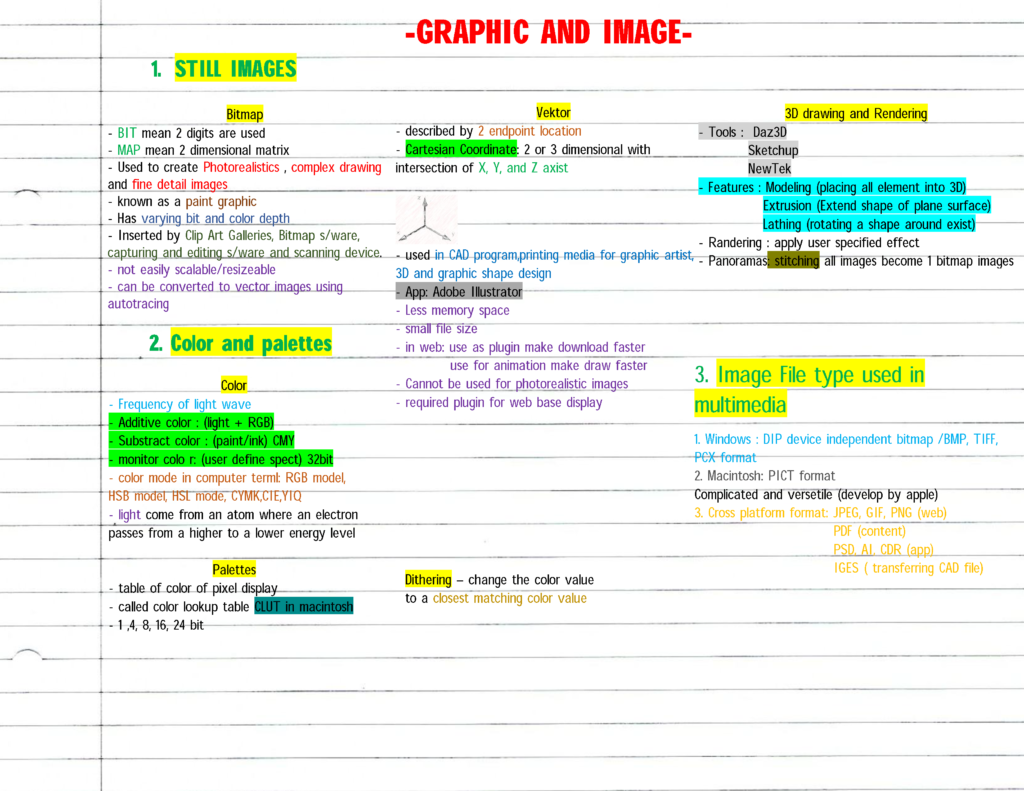
3.1 Beginning to Create Images
3.2 Creating Still Images
3.3 Understanding Colors
3.4 File Formats


2.1 Importance of Text
2.2 Attribute of Text
2.3 Usage of Text in Multimedia
2.4 Usage of Text in Computer
2.5 Font Editing and Design Tools
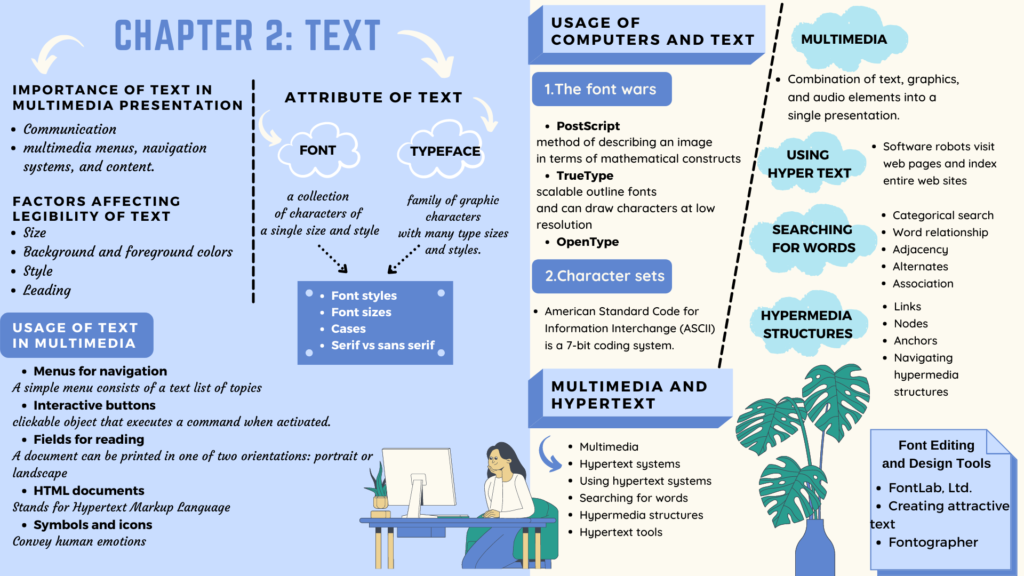
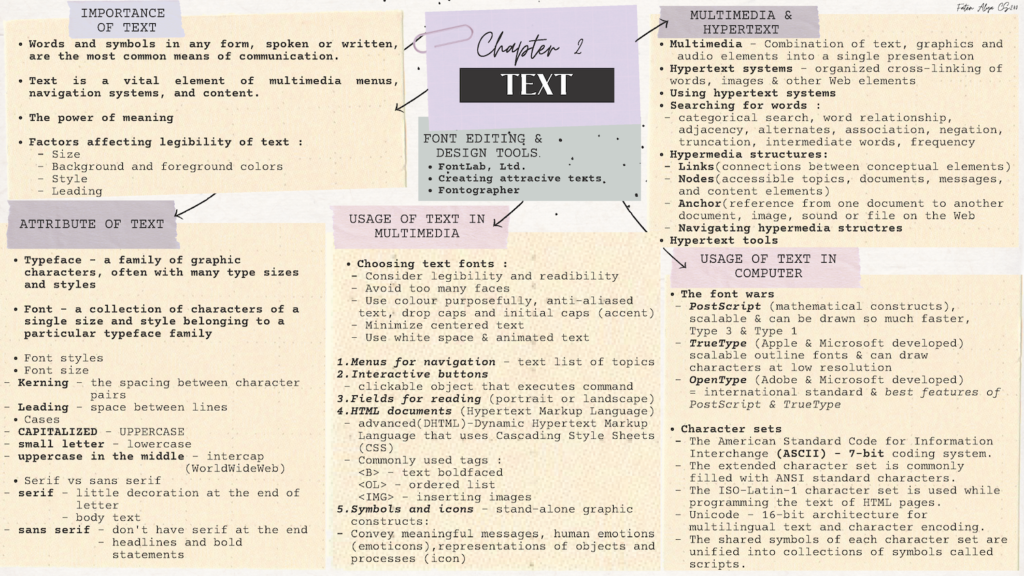
1.1 Basic definition
1.2 Media of Delivery
1.3 Common Usage of Multimedia
1.4 Understanding Virtual Reality


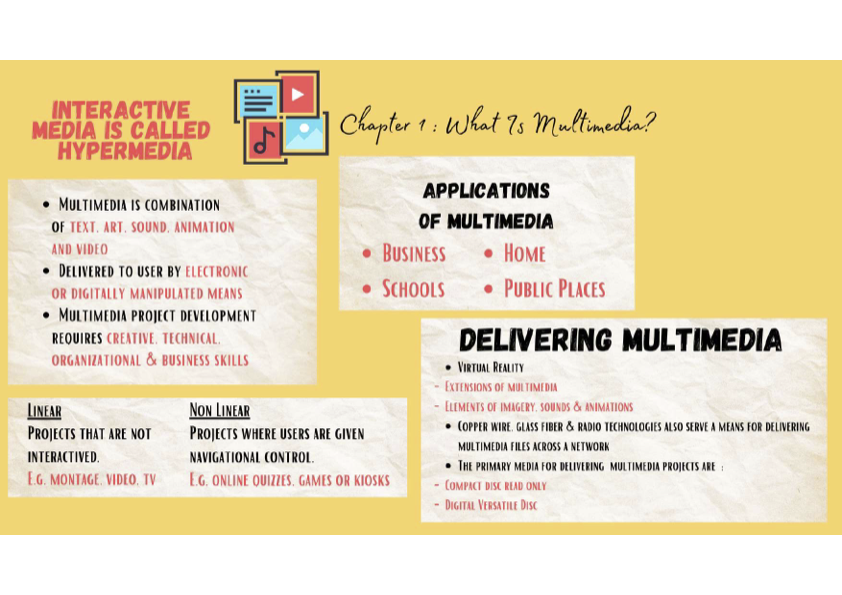
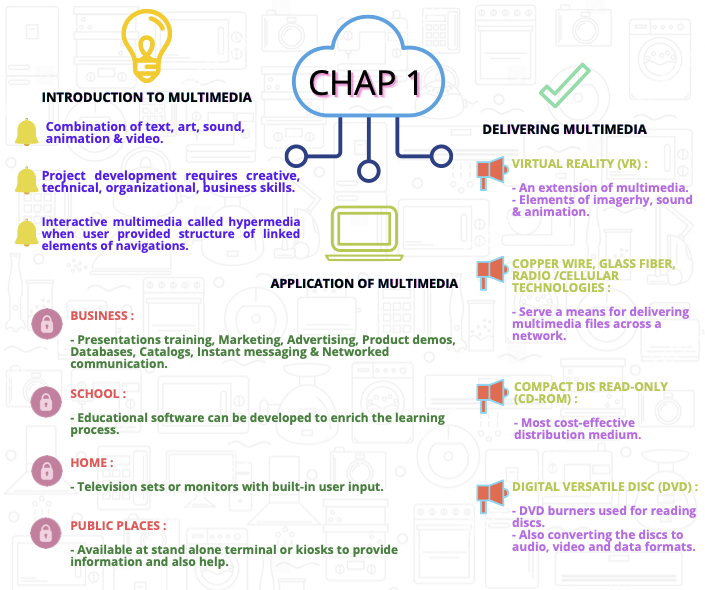
Chapter 1 – Introduction to Mobile Programming
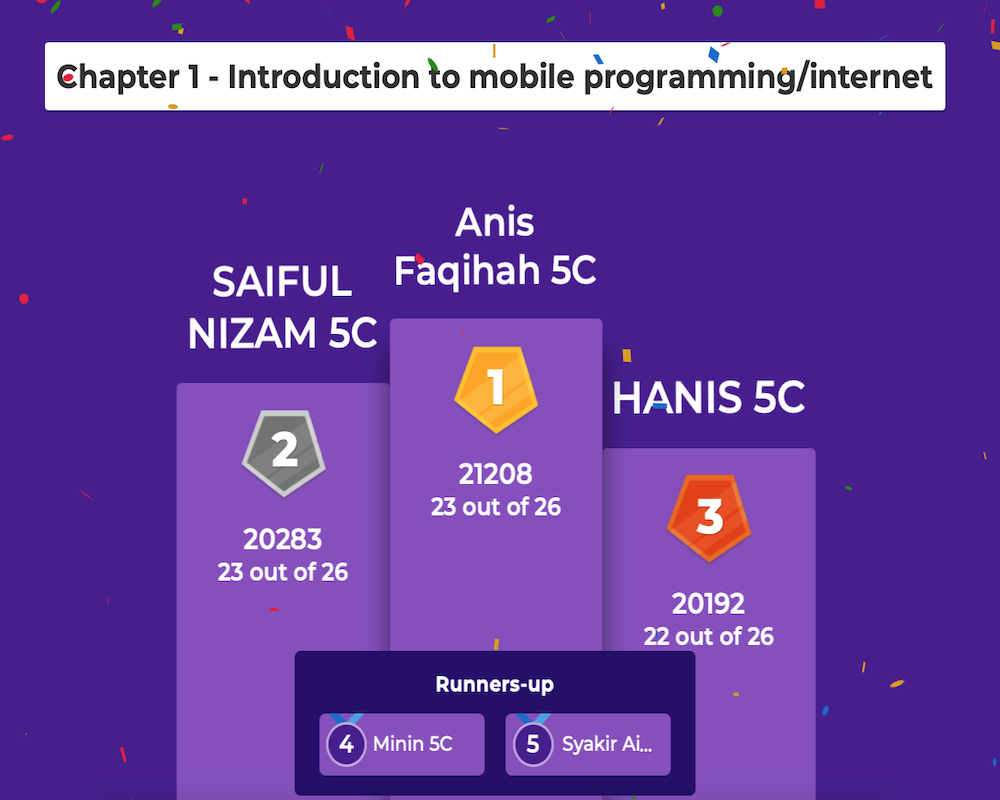
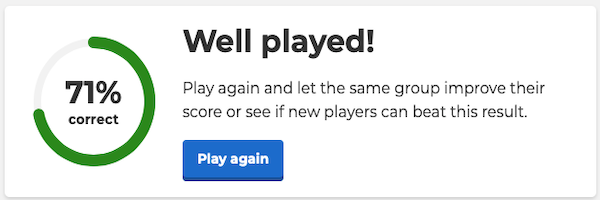
Chapter 2 – Android Operating Systems
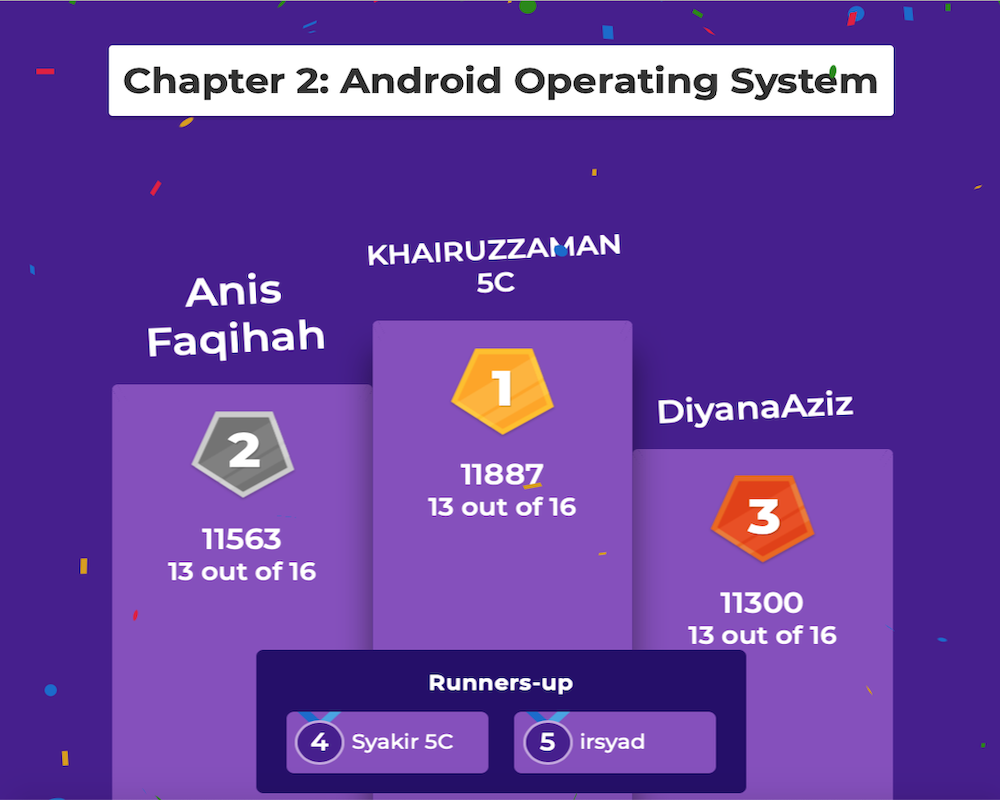
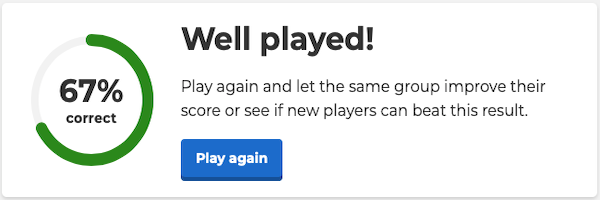
Chapter 3 – Android studio
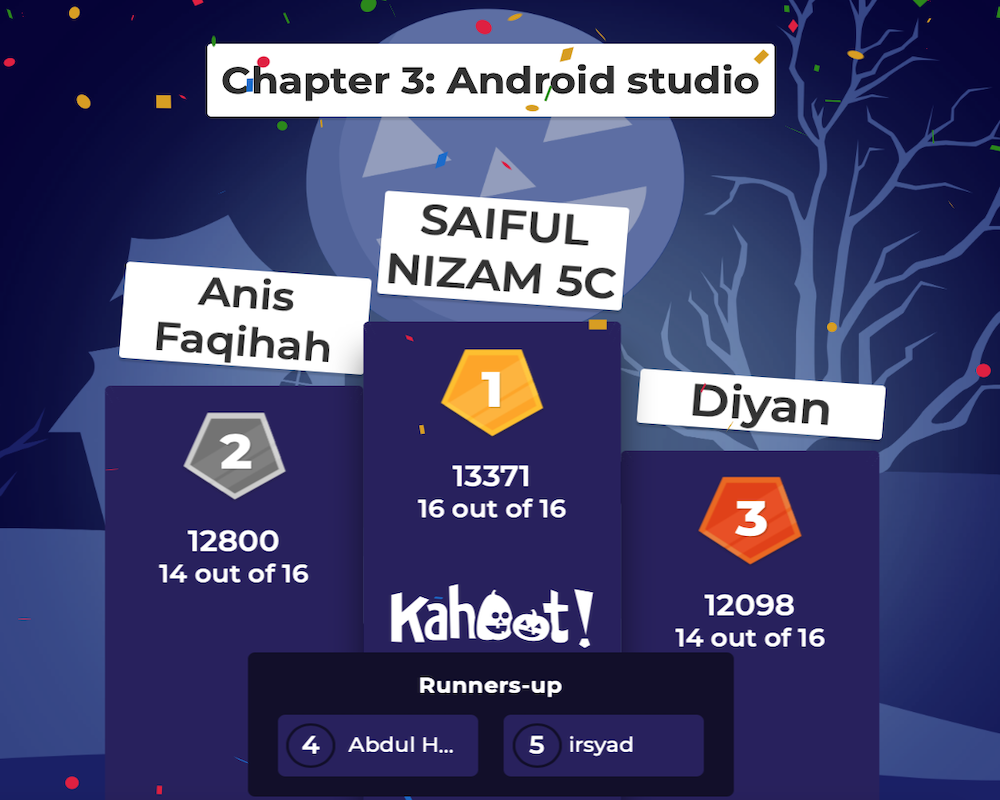
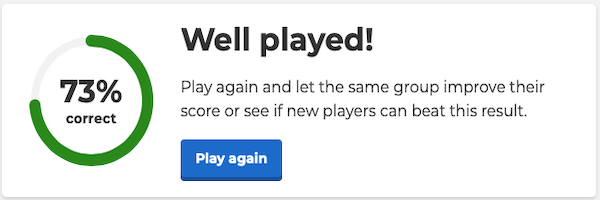
Chapter 4 – Developing Application I
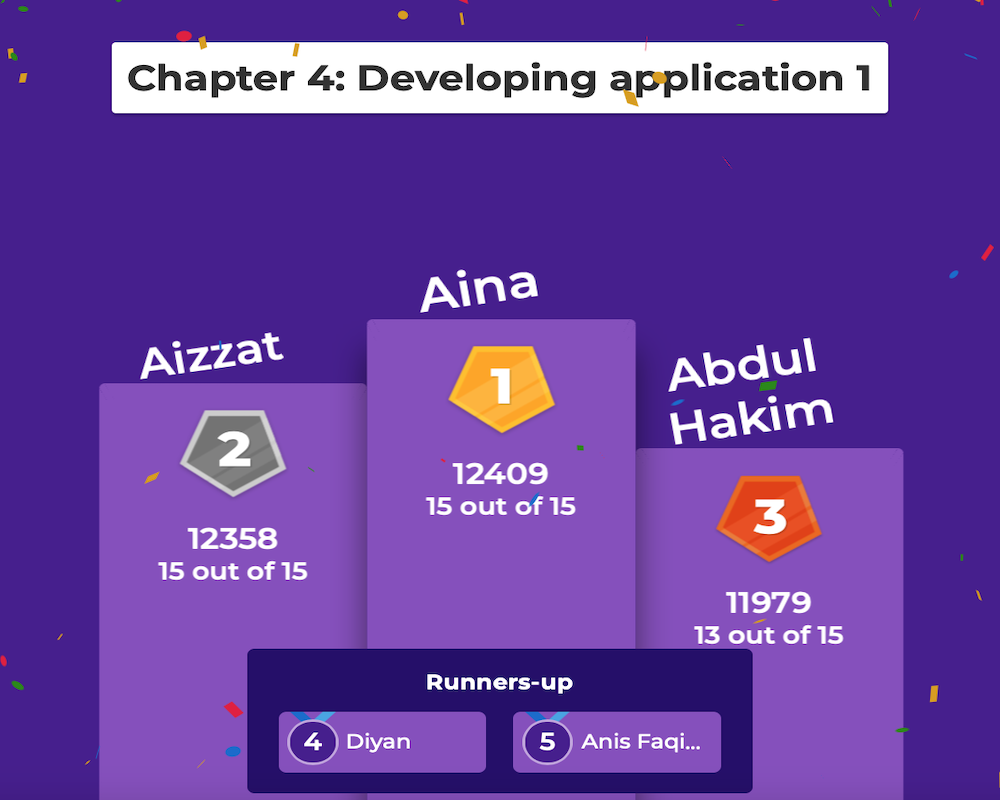
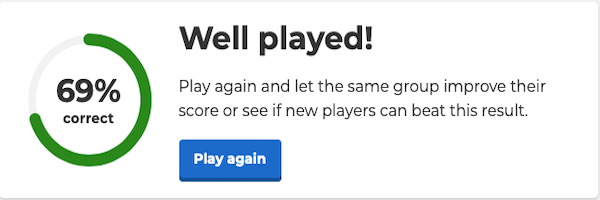
Chapter 5 – Developing Application II
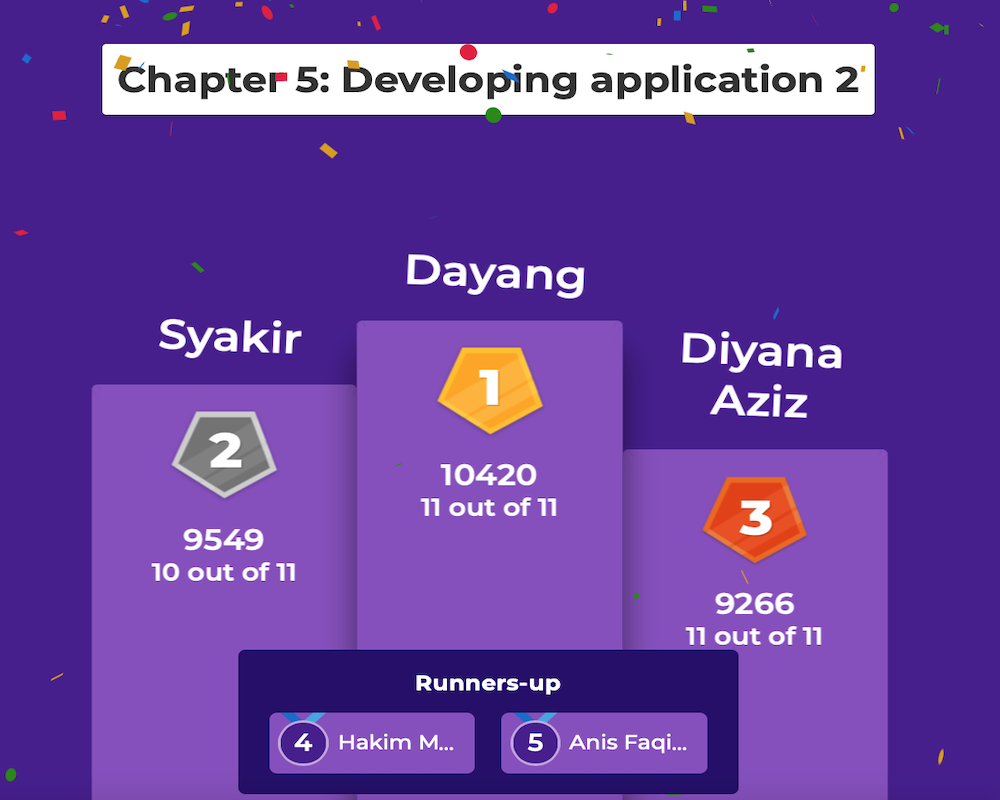
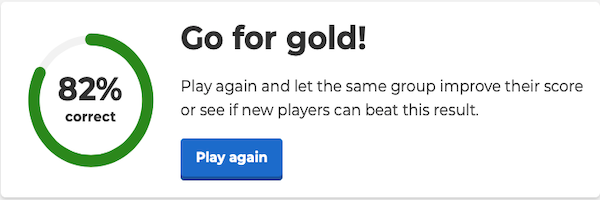
Chapter 6 – Mobile Database
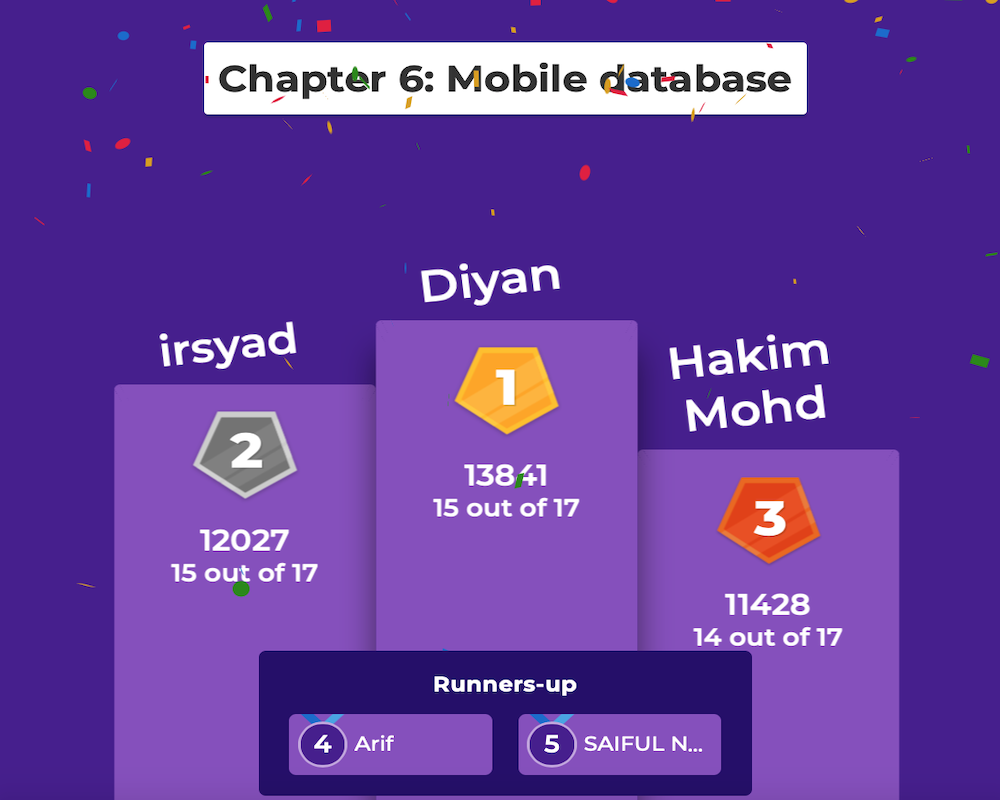
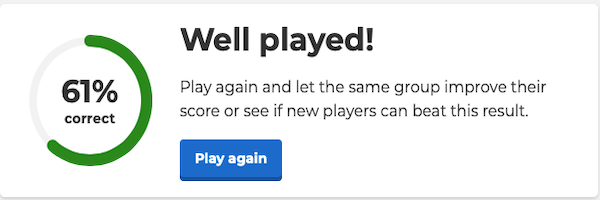
Chapter 7 – Implementing CRUD
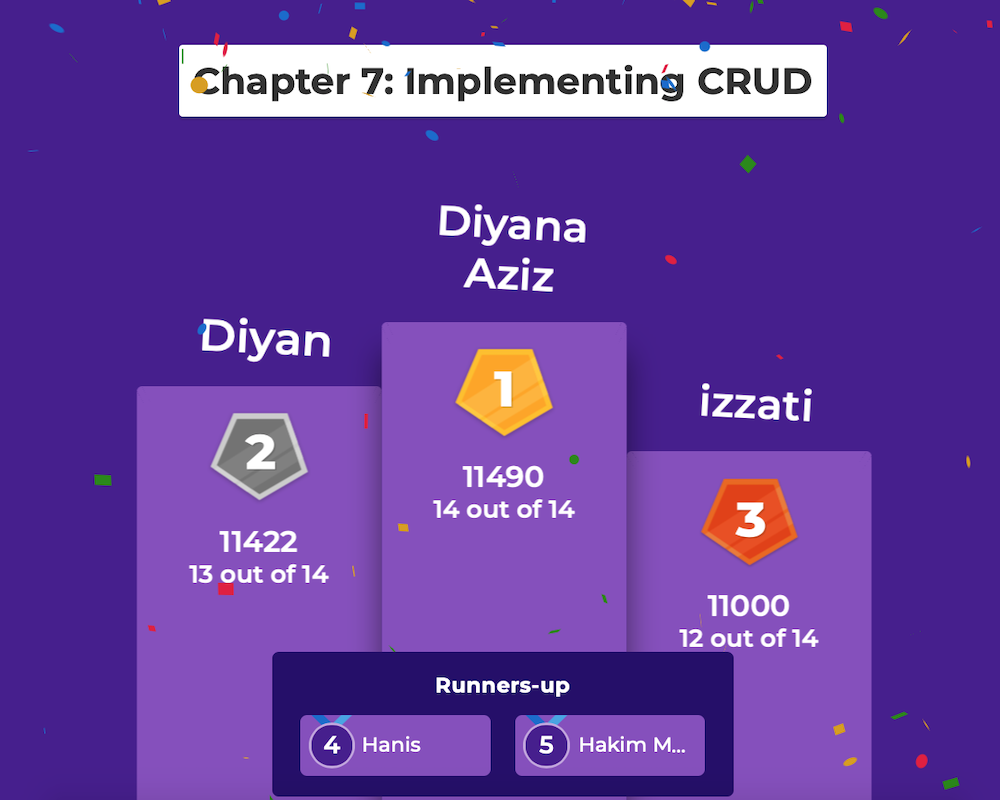

Chapter 8 – Testing and Publishing Apps
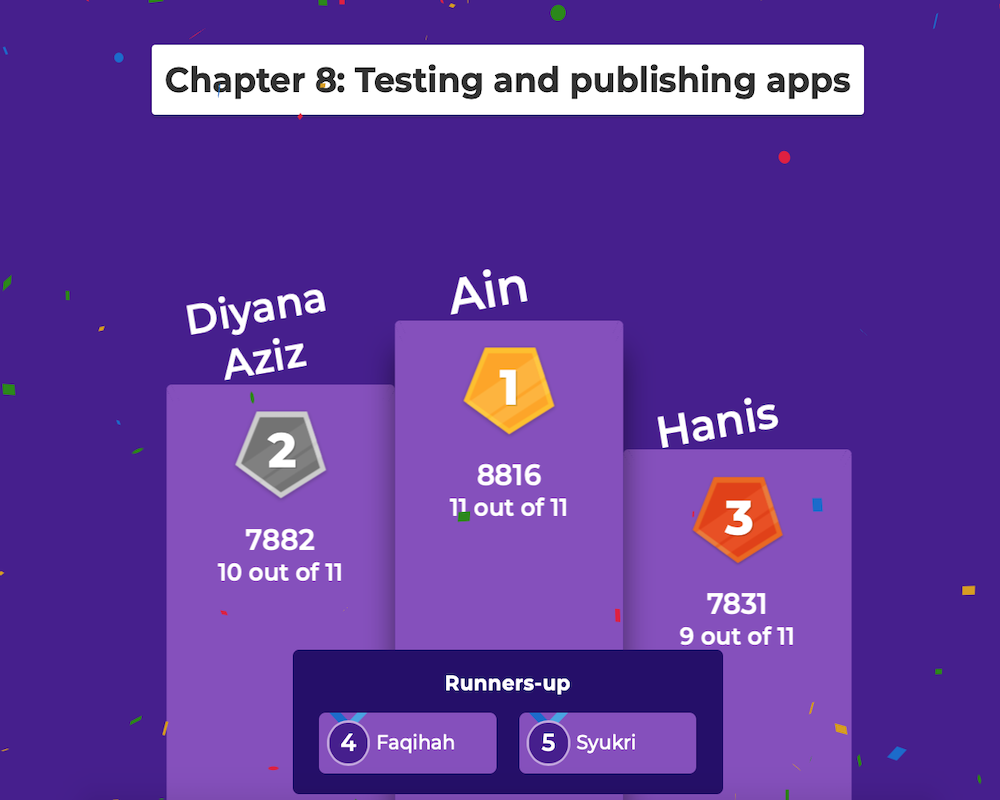
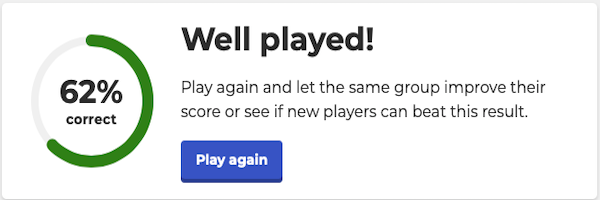
Quizzes : 10%
Lab Assignment : 30%
Test 1 : 20%
Test 2 : 20%
Group Project : 30%
Total: 100%
Passing grade : C ( 50 % )
Date: 6/12/2021 (Monday)
Time: 8.15 – 9.15 am
Duration: 1 Hours (excluding submission time 15 minutes)
Chapter 1-4
Type:
Part A – Objective- (20 questions) – 20 marks
Part B – Subjectives (2 short questions) – 30 marks
Offline and not open book test
Just type your answer in the paper and attach it as .pdf file in UFuture.
Hint: Code the xml file. So please remember everything to code the layout in xml.
GOOD LUCK 🙂
Date: 26/1/2022 (Wednesday)
Time: 10.15 – 11.15 am
Duration: 1 Hours (excluding submission time 10 minutes)
Chapter 5-8
Type:
Part A – Objective- (20 questions) – 20 marks (Close book)
Part B – Subjectives (2 short questions) – 30 marks (Open book for Part B (Question 2 only)
Just type your answer in the paper and attach it as .pdf file in UFuture.
Hint: Code the xml and java file.
GOOD LUCK 🙂
This lab assignment is an individual assignment. Students can discuss and refer to any related resources as long as they manage to design and develop the mobile app by themselves. In this lab assignment, students are required to use Android Studio IDE.
This lab assignment is about personal app. It is meant that students can share information about themselves such as:
Note: Please use your own creativity to develop the above pages.
It also has quick links to UiTM Website and iStudent Portal.
App icon and splash screen should be included.
There are several elements to take into the consideration in developing the mobile app.
Students have two weeks to finish this lab assignment. For the time being, I will evaluate it using your mobile phones. In case if you don’t have any android device, I will evaluate it through the emulator.
Please see the appendix for the example of the mobile app pages.
Appendix: The example of the mobile application pages are shown as below:
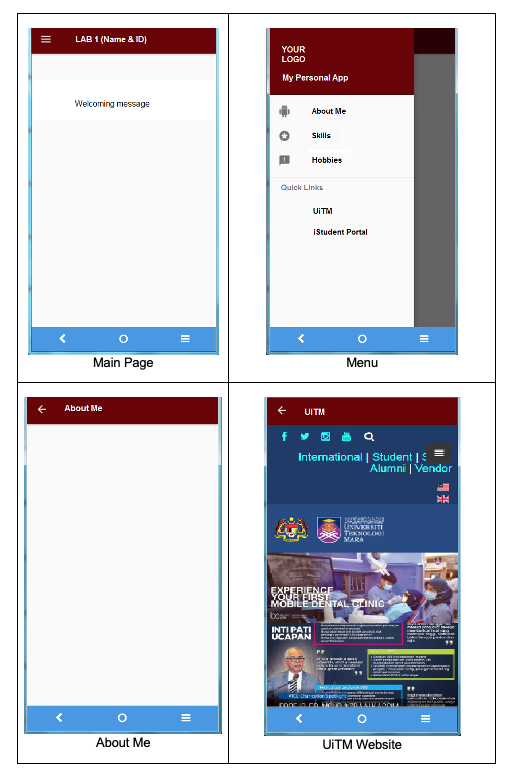
What to submit:
Put both of the files in the google drive and share the link in the UFuture (I will create the assignment in UFuture later).
The evaluation rubric
| Criteria | CONTENTS (3 PAGES) (1-5) | ELEMENTS (5 FEATURES) (1-5) | CORRECTNESS (1-5) | INTERFACE (1-5) | COMPLETION (1-5) |
| Description | 3 pages existed in the application | All 5 features are used in the application | The application is correctly developed without error | The view of the interface | The completion of the application |
Group project requirement
This group project is especially designed as a platform for students to improve their soft skills such as logical thinking, critical thinking, problem solving, programming and esprit de corps. The ideal group size is 4 – 5 members. It is recommended that the group size is as small as possible. By doing this, perhaps each student will give full commitment to the project. This is to make sure that there is no sleeping partners in the group. A project leader is appointed and responsible to the success of the group.
The time duration of the group project is seven weeks starting from assigning the project title until the project presentation.
Each group is required to provide with the followings:
Report
Format:
Content
Application
Please ensure that the mobile application adheres to the following conditions:
Implementation
The evaluation rubric
| 5 – 4 marks | 3 – 2 marks | 1 – 0 mark | |
| 1. Organization | The contents are organized and explained very well | The contents are less organized and explained | The contents are notorganized and explained at all |
| 2. Contribution | All requirements and objectives are identified, evaluated and completed | All requirements are identified and evaluated but some objectives arenot completed | Many requirements and objectives are not identified, evaluatedand/or completed |
| 5 – 4 marks | 3 – 2 marks | 1 – 0 mark | |
| 1. UserInterface | Interface is neat and well organized | Interface is reasonably neat | Interface is untidy and not organized |
| 2. Run without error | Runs smoothly and without errors | Runs but with some errors | Still contain error or warning |
| 3. Correctness | Application is according to theoriginal proposal and givescorrect output | Application follows the original partially or givessome incorrect output | Application is completely incorrect |
| 4. Database | CRUD functions for at least one table without errors | CRUD functions for at least one table with some errors | No database used at all |
The full marks are 30 marks in which 10 marks for the report and 20 marks for the mobile app.
This course introduces students to programming technologies for designing, building and publishing related to internet programming. It provides students with fundamental knowledge and techniques required to access device capabilities, current technologies and standards, operating system for Software Development Kit (SDK) and mobile programming. Upon completion, students should be able to create an efficient application for mobile devices.
At the end of the course, students should be able to:
| Topic | Remarks |
|---|---|
| WEEK 1 (11/10 – 15/10) Introduction to the course | Start Entrance Survey (11-24 October) Lecture ebooks: Ebooks |
| WEEK 2 (18/10 – 22/10) Chapter 1 – Introduction to Mobile Programming 1.1 Internet and networking 1.2 HTML, XML and CSS 1.3 Java 1.4 Mobile Apps architecture 1.5 Mobile Apps vs. Web Apps 1.6 Android vs. IOS | Lecture note 1: Introduction to Mobile Programming Lab 1: Installation and develop my first app |
| WEEK 3 (25/10 – 29/10) Chapter 2 – Android Operating Systems 2.1 History 2.2 Features 2.3 Version 2.4 Android architecture | End Entrance Survey Lecture note 2: Android Operating Systems Lab 2: XML and layout in Andriod |
| WEEK 4 (1/11 – 5/11) Chapter 3 – Android studio 3.1 Getting Started 3.2 First App 3.3 AndroidManifest File 3.4 Activities, Fragment, Services, Intent and UI Widgets 3.5 Layouts 3.6 Containers 3.7 Menu | Start Lab assignment – 30% Lecture note 3: Android studio Lab 3: UI view in Android |
| WEEK 5 (8/11 – 12/11) Chapter 4 – Developing Application I 4.1 UI Widgets 4.2 Data and Time 4.3 Toast 4.4 Containers 4.5 Menu | Lecture note 4: Developing Application I Lab 4: Android widgets |
| WEEK 6 (15/11 – 19/11) Chapter 5 – Developing Application II 5.1 Fragment and Intent 5.2 Notification 5.3 Material Design 5.4 Navigation | Lecture note 5: Developing Application II Lab 5: Andriod navigation |
| (22/11 – 26/11) | SEMESTER BREAK (CUTI PERAYAAN) |
| WEEK 7 (29/11 – 3/12) Chapter 6 – Mobile Database 6.1 Introduction 6.2 Database design 6.3 Database connection 6.4 Database access using SQL | Project briefing (Create groups) Submit lab assignment – 30% (5/12/2021) Start group project – 30% Lecture note 6: Mobile Database Lab 6: Android database(SQLite) |
| WEEK 8 (6/12 – 10/12) Test 1 – (20%) | Test 1 – (6/12/2021) (20%) Lab 7: Android database(MySQL) |
| WEEK 9 (13/12 – 17/12) Chapter 7 – Implementing CRUD 7.1 Login and Logout and registration 7.2 Add, Retrieve, Update & Delete Operations 7.3 Reporting 7.4 Searching | Project proposal submission (17/12/2021) Lecture note 7: Implementing CRUD Lab 8: SQLite CRUD |
| WEEK 10 (20/12 – 24/12) Chapter 8 – Testing and Publishing Apps 8.1 Mobile application and delivery 8.2 Testing mobile application 8.3 Application distribution | Start Student Feedback Online (SuFO) Lecture note 8: Testing and Publishing Apps Lab 9: Testing and publishing |
| (27/12 – 31/12) | CUTI KHAS PERAYAAN |
| WEEK 11 (3/1 – 7/1) Group project preparation | Lab 9: Project preparation |
| WEEK 12 (10/1 – 14/1) Group project preparation | Lab 10: Project preparation |
| WEEK 13 (17/1 – 21/1) Group project preparation | Start Exit Survey (17-30 January 2021) Start Exit Student Feedback Online (SuFO (20/12/2021 – 6/2/2022) Project preparation |
| WEEK 14 (24/1 – 28/1) Test 2 – (20%) | Test 2 – (26/1/2022) (20%) End Exit Survey End Exit Student Feedback Online (SuFO) Project preparation |
| (31/1 – 4/2) Group project presentation | Submit group project – 30% (31/1/2021) Group project presentation (3-4/2/2022) Study week |
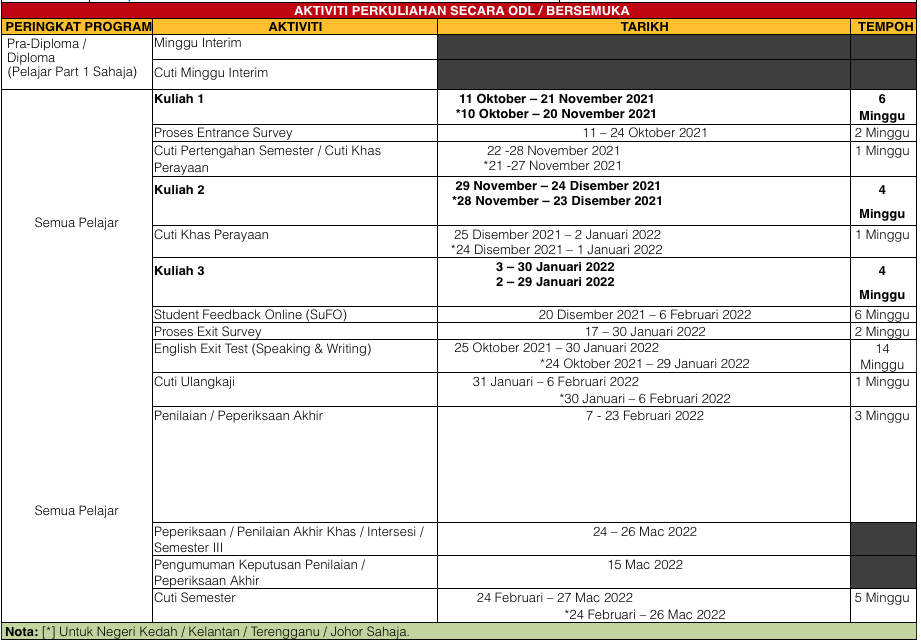
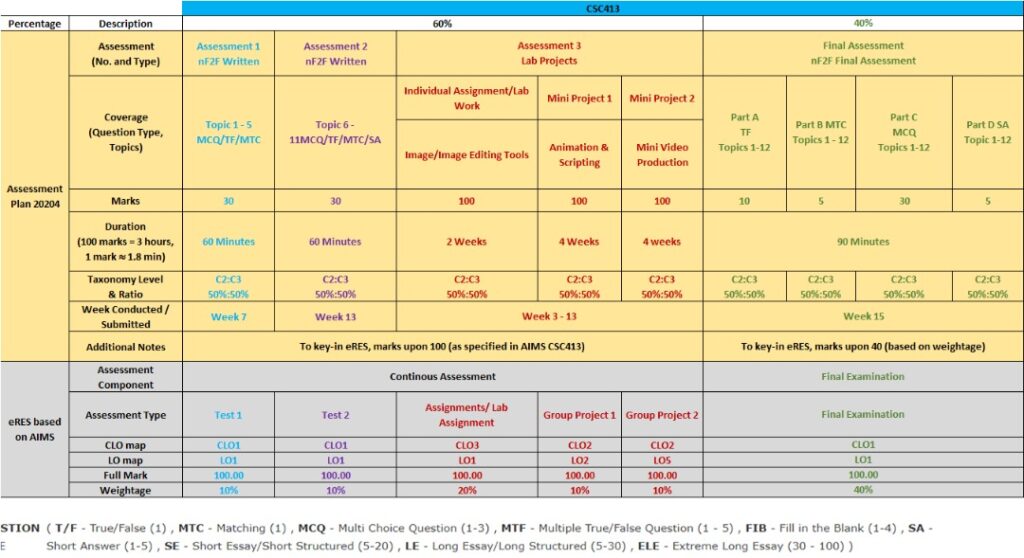
Lab assignment – 20%
Group project – 20%
Test 1 – 10%
Test 2 – 10%
Final assessment – 40%
Total : 100%
Passing grade:C (50%)
Topic 1 – 6
Objective and subjective
Topic 7 – 12
Objective
TITLE: POSTER
Poster is one of the best ways to advertise and deliver your message to the end user. Your goal is to create a promotional poster for upcoming event of your organization. You need to plan on how you want to organize the information so that it is easy to the people to capture the message.
Detail for poster as per following:
ORIGINALITY: Since we’ve been doing some tutorials and you’ve been honing your skills; I do want to see clear evidence that you are learning to create your own effects rather than relying on simply copying and pasting. 90% or more of the cover design has to be of your own ORIGINAL creation. At this point all of your layers must skillfully blend seamlessly together.
All pictures must be of high quality, high resolution images. You will save your work as a .jpg file and .psd. Include all of the following text elements into your cover:
* Event title
* Organization logo
* Sponsor logo (if any)
* Event details: Time, date, venue, contact person etc. (Use your date of birth for date, and venue is a place in your hometown
* Picture of the main speaker(s) / guest(s) (Use your own picture)
* Images and graphics related to cover
* Other related information
Submission
Upload the project file (.psd) and exported poster in .jpg file format in the assignment (UFuture). Assignment will be created later.
Submission
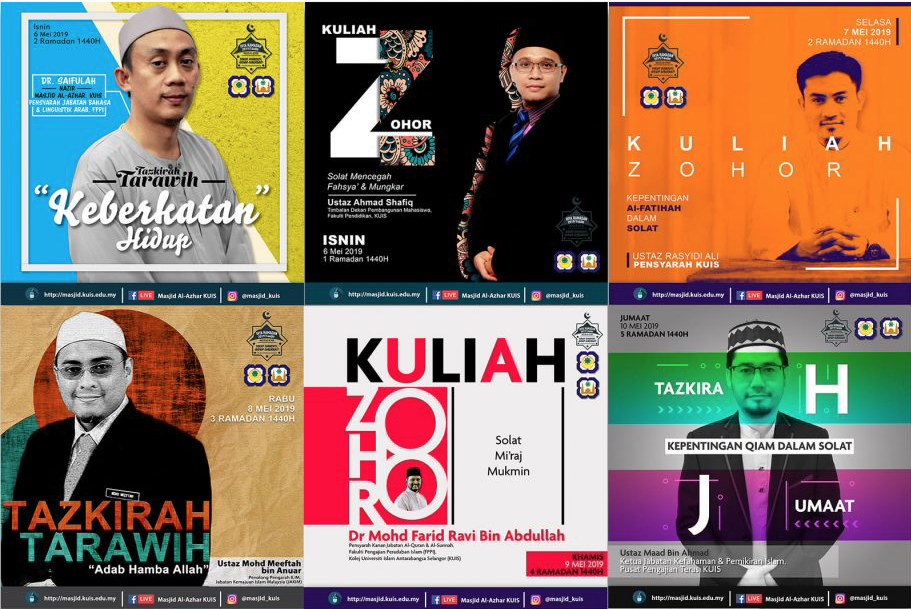
Marking Rubric
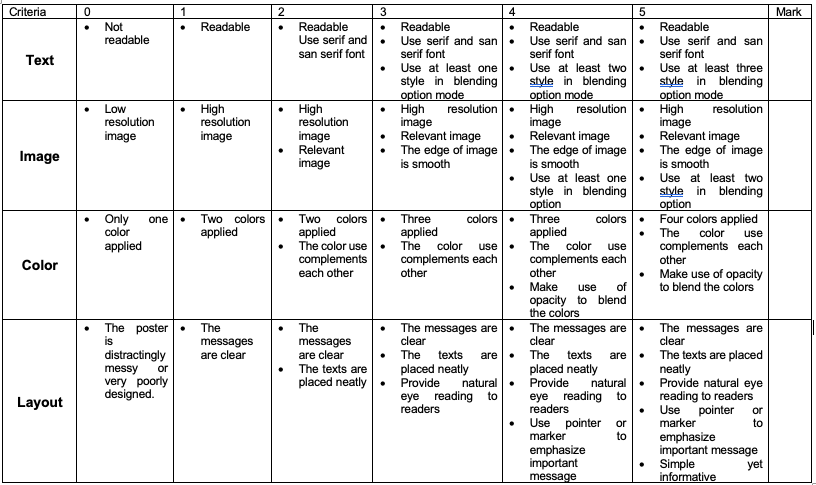
GROUP PROJECT (4 persons)
TITLE: CREATIVE VIDEO
Students are required to prepare a project storyboard. The storyboard must use computer generated (Microsoft PowerPoint / any presentation tool ) format.
*please include important information (group members’ name, matrix no., group name, group (class) on your project storyboard cover.
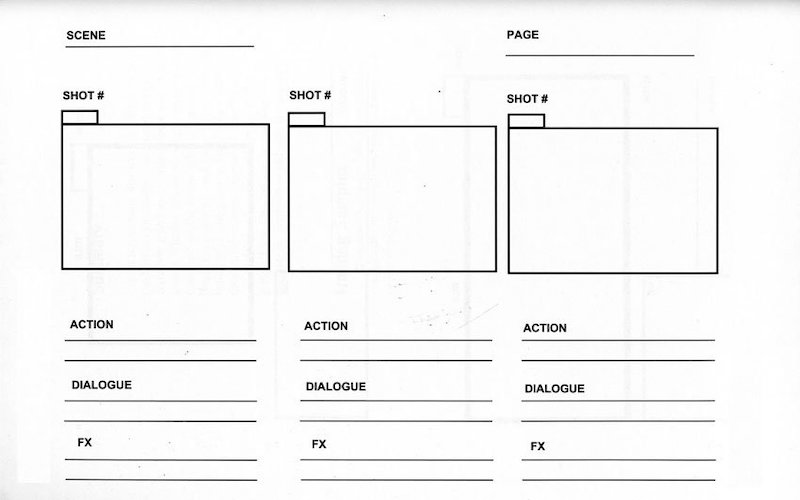
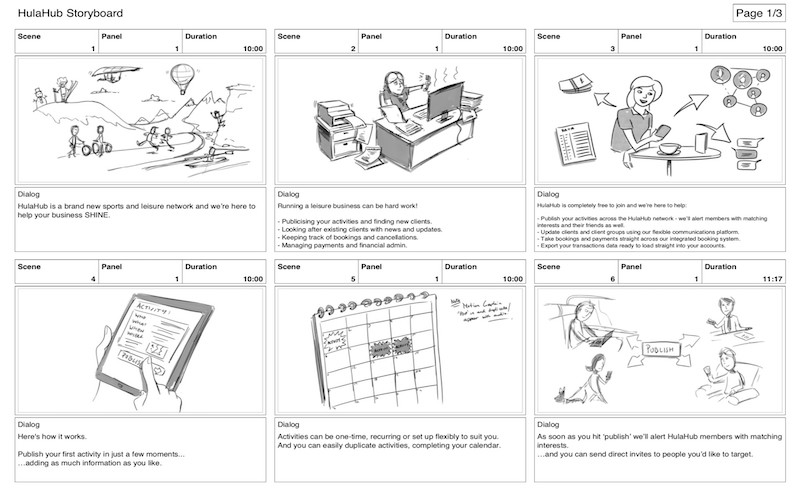
Marking Rubric:
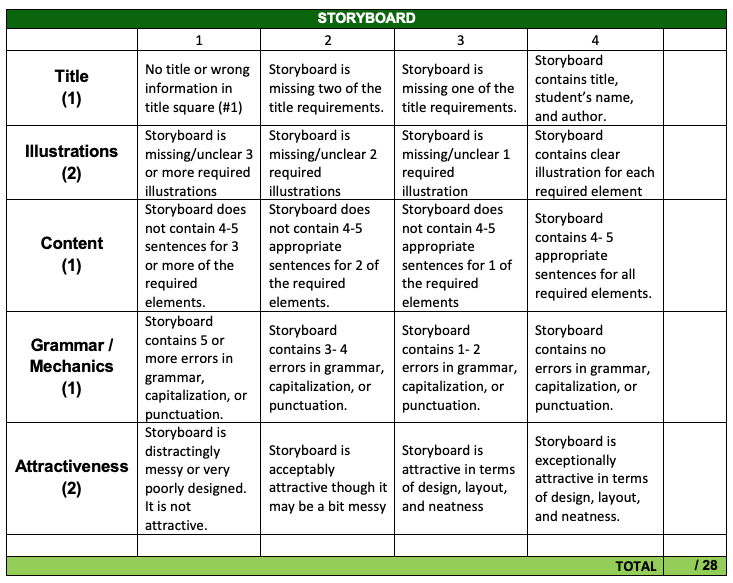
VIDEO PROJECT GUIDELINES
Duration : 5 to 7 minutes
Delivery medium : YouTube Channel
Language : English/Malay
Subtitle : English/Malay
Features : Green screen, transition, music background, sound effect, spoken speech
You can choose any theme listed for your video.
Marking Rubric:
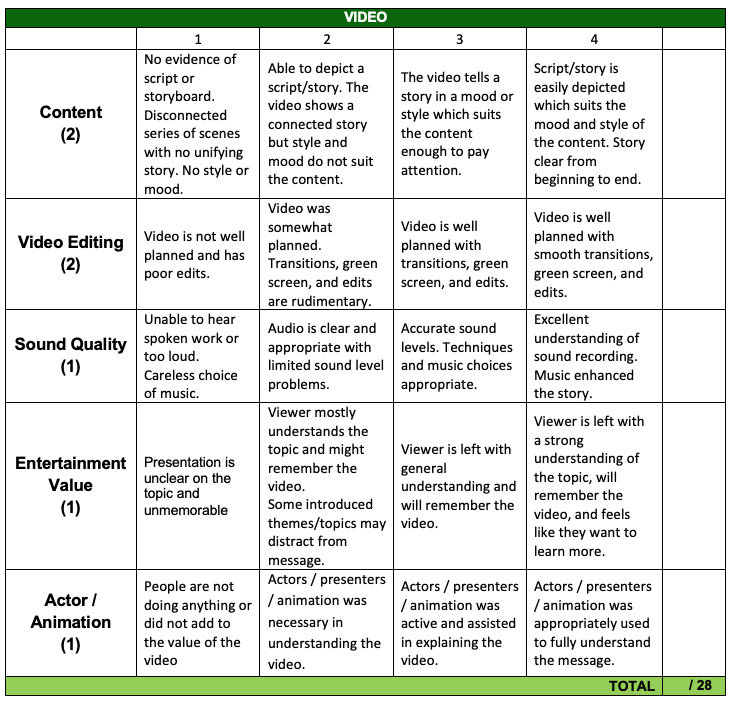
Time: 9 – 12 PM
All chapters included.
This course will introduce the essential topics in multimedia application development. It includes concepts in hypermedia, basic process and techniques in multimedia application development such as effective combination of audio, video, animation and graphics. Beside that, the implications of data storage and retrieval methods and also the role of teamwork in multimedia application development will also be highlighted. It will also discuss on multimedia computer hardware, current multimedia software packages, multimedia application concepts, data manipulation, file formats, media storage and memory management and configurations. Applications of multimedia for mobile and the Internet will also be emphasized.
At the end of the course, students should be able to:
| Topic | Remarks |
|---|---|
| WEEK 1 (11/10 – 15/10) Course introduction | Start Entrance Survey (11-24 October) |
| WEEK 2 (18/10 – 22/10) Chapter 1 – Introduction 1.1 Basic definition 1.2 Media of Delivery 1.3 Common Usage of Multimedia 1.4 Understanding Virtual Reality | Lecture note 1: Introduction Lab 1 & 2: Adobe Photoshop/Photopea (Installation) |
| WEEK 3 (25/10 – 29/10) Chapter 2 – Text 2.1 Importance of Text 2.2 Attribute of Text 2.3 Usage of Text in Multimedia 2.4 Usage of Text in Computer 2.5 Font Editing and Design Tools | Lecture note 2: Text Lab 3 & 4: Adobe Photoshop/Photopea |
| WEEK 4 (1/11 – 5/11) Chapter 3 – Graphic & image 3.1 Beginning to Create Images 3.2 Creating Still Images 3.3 Understanding Colors 3.4 File Formats | End Entrance Survey Lecture note 3: Graphic Lab 5, 6 & 7: Adobe Photoshop/Photopea |
| WEEK 5 (8/11 – 12/11) Chapter 4 – Sound 4.1 Introduction to Sound 4.2 Multimedia System Sound 4.3 Digital Audio 4.4 MIDI Audio 4.5 Comparing Digital to MIDI Audio 4.6 Creating and Editing Digital Audio Files 4.7 MIDI versus Digital Audio 4.8 File Formats 4.9 Applying Sound to Multimedia Project | Start Individual Assignment- 20% Lecture note 4: Sound Lab 8: Audacity |
| WEEK 6 (15/11 – 19/11) Chapter 5 – Animation 5.1 Introduction to Animation 5.2 Principles of Animation 5.3 Traditional Animation? 5.4 Computer Animation 5.5 File Formats 5.6 Creating Animation | Lecture note 5: Animation Lab 9 & 10: Audacity |
| (22/11 – 26/11) | CUTI KHAS PERAYAAN |
| WEEK 7 (29/11 – 3/12) Chapter 6 – Video 6.1 Introduction to Video 6.2 How Video Works and Displayed 6.3 Playing Back Digital Video Files 6.4 Shooting and Editing Video 6.5 File Formats | Submit Individual Assignment- 20% (3/12/2021) Lecture note 6: Video Lab 11: Adobe Premier/Filmora |
| WEEK 8 (6/12 – 10/12) Chapter 7 – Multimedia development 7.1 Stages of Multimedia Project 7.2 Project Requirements 7.3 Team and Skillsets | Test 1 (Topic 1 – 6) – 10% (8/12/2021) Start Group Project- 20% Lecture note 7: Multimedia development Lab 12: Adobe Premier/Filmora |
| WEEK 9 (13/12 – 17/12) Chapter 8 – Hardware for development 8.1 Popular Platforms 8.2 Various Type of Connections 8.3 Memory and Various Storage Devices 8.4 Various Input and Output Devices | Lecture note 8: Hardware for development Lab 13: Adobe Premier/Filmora |
| WEEK 10 (20/12 – 24/12) Chapter 9 – Software for development 9.1 Text Editing and Word Processing 9.2 OCR Software 9.3 Painting and Drawing Tools 9.4 3-D Modeling and Animation Tools 9.5 Image-Editing Tools 9.6 Sound Editing Tools | Submit project storyboard- 5% (24/12/2021) Start Student Feedback Online (SuFO) Lecture note 9: Software for development Lab 14: Adobe Animate/Flash |
| (27/12 – 31/12) | CUTI KHAS PERAYAAN |
| WEEK 11 (3/1 – 7/1) Chapter 10 – Authoring multimedia elements 10.1 Introduction to Authoring Systems 10.2 Types of Authoring Tools 10.3 Choosing Authoring Tools 10.4 Testing 10.5 Preparing for Delivery | Lecture note 10: Authoring multimedia elements Lab 15: Adobe Animate/Flash |
| WEEK 12 (10/1 – 14/1) Chapter 11 – The internet and multimedia 11.1 History of Internet 11.2 Internetworking 11.3 Making Multimedia for the Web | Lecture note 11: The internet and multimedia Lab 16: Group project preparation |
| WEEK 13 (17/1 – 21/1) Chapter 12 – Mobile multimedia 12.1 Digital Revolution 12.2 Mobile Hardware 12.3 Various Types of Connections 12.4 Mobile Platform 12.5 Programming Mobile Applications | Submit Group Project- 20% (25/1/2022) Start Exit Survey (17-30 January 2021) Start Exit Student Feedback Online (SuFO (20/12/2021 – 6/2/2022) Lecture note 12: Mobile multimedia Lab 17: Group project preparation |
| WEEK 14 (24/1 – 28/1) Group project presentation | Test 2 (Topic 7 – 12) – 10% (26/1/2022) Video Project submission (25/1/2022) Exit Survey Exit Student Feedback Online (SuFO) |
| (31/1 – 4/2) | Study week |
| WEEK 15 (7/2 – 11/2) Final assessment- 40% | Final examination (10/2/2022) Example of past year questions |
